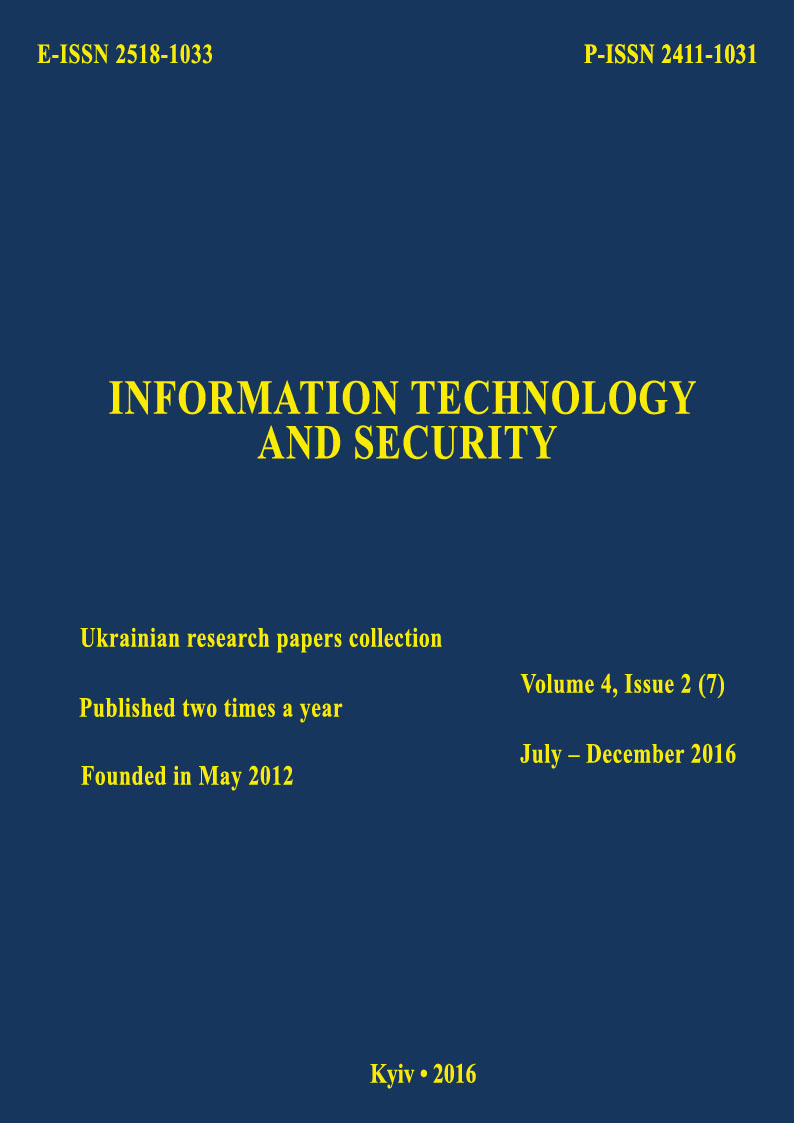Formation of non-uniformity increment for the basic module base in the problem of Fermat’s factorization method
DOI:
https://doi.org/10.20535/2411-1031.2016.4.2.110001Keywords:
Factorization, Fermat’s factorization method, thinning, sieve method, acceleration.Abstract
One way to ensure the specified level of information security is the use of asymmetric encryption algorithms. The cryptographic durability of such algorithms is based on the difficulty of execution the factorization problem. Modern methods of decomposition of multiple-bit sequences at factors are based on the fundamental concepts of classical Fermat's factoring algorithm. Some of the possible directions of the acceleration Fermat’s method include reducing the number of arithmetically complex operations extracting the square root. The modular division procedure using several module bases (the sieve method) allows you to exclude from consideration the options of acceptable values of X, which do not satisfy the condition Х2=N+Y. In the process of research the modification Fermat's factorization method it has been determined that it is possible to use not the pre-sieved high values of X during the search for a solution of equation Y2= X2-N, but increments to them that are the small numbers. A method of forming a non-uniform incremental data for the valid values of X relation to the basic module base during the factorization of numbers with Fermat's method is offered. It can significantly reduce the number of scanned values. Furthermore, the use of this algorithm provide not more than one addition operation of multi-bit numbers. All other operations are carried out with small numbers usually not exceeding 215.
References
D. Brown, “Breaking RSA may be as difficult as factoring”, Journal of Cryptology, vol. 29, iss. 1, pp. 220-241, January 2016.
doi: 10.1007/s00145-014-9192-y.
О.Н. Василенко. Теоретико-числовые алгоритмы в криптографии. Москва, Россия: МЦНМО, 2003.
R.S. Lehman, “Factoring Large Integers”, Mathematics of Computation, vol. 28. iss.126, pp. 637-646, 1974.
doi: 10.1090/S0025-5718-1974-0340163-2.
Д. Кнут. Искусство программирования. Том 2. Москва, Россия: Viliams, 2007.
S.D. Vynnychuk, A.V. Zhylyn, and V.N. Mysko, “Algoritm Ferma faktorizatsii chisel vida N=p*q metodom prorezhivaniia”, Electronic Modeling, vol. 36, iss. 2, pp. 3-14, 2014.
Y.V. Maksymenko, “The way of effective use of incremental with multiple thinning of test values for Fermat’s factoring method”, Information Technology and Security, vol. 4, iss. 1, pp. 13-24, 2016.
S.D. Vynnychuk, and Ye.V. Maksymenko, “Multiple thinning to accelerate Fermat's method of factorization with uneven steps for the unknown”, Proceedings of the National technical university of Ukraine “KPI”: Informatyka, management and computing, iss. 64, pp. 13-24, 2016.
Y.V. Maksymenko, “Selection of effective basic basis of module with multiple thinning trial value in the factorization Fermat's method with irregular pitch”, Informatics & Mathematical Methods in Simulation, vol. 6, iss. 3, pp. 270-279, 2016.
Downloads
Published
How to Cite
Issue
Section
License
Copyright (c) 2020 Collection "Information technology and security"

This work is licensed under a Creative Commons Attribution 4.0 International License.
The authors that are published in this collection, agree to the following terms:
- The authors reserve the right to authorship of their work and pass the collection right of first publication this work is licensed under the Creative Commons Attribution License, which allows others to freely distribute the published work with the obligatory reference to the authors of the original work and the first publication of the work in this collection.
- The authors have the right to conclude an agreement on exclusive distribution of the work in the form in which it was published this anthology (for example, to place the work in a digital repository institution or to publish in the structure of the monograph), provided that references to the first publication of the work in this collection.
- Policy of the journal allows and encourages the placement of authors on the Internet (for example, in storage facilities or on personal web sites) the manuscript of the work, prior to the submission of the manuscript to the editor, and during its editorial processing, as it contributes to productive scientific discussion and positive effect on the efficiency and dynamics of citations of published work (see The Effect of Open Access).

